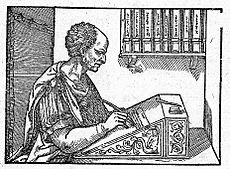- The Nun's Priest's Tale
-
 Cicero, one of the authors in the cockerel's "library"
Cicero, one of the authors in the cockerel's "library"
The Nun's Priest's Tale is one of The Canterbury Tales by the Middle English poet Geoffrey Chaucer. Composed in the 1390s, the 626-line narrative poem is a beast fable and mock epic based on an incident in the Reynard cycle. The story of Chanticleer and the Fox became further popularised in Britain through this means.
Contents
The tale and framing narrative
The prologue clearly links the story with the previous Monk's Tale, a series of short accounts of toppled despots, criminals and fallen heroes which prompts an interruption from the knight. The host upholds the knight's complaint and orders the monk to change his story. The monk refuses, saying he has no lust to pleye, and so the Host calls on the Nun's Priest to give the next tale. There is no substantial depiction of this character in Chaucer's General Prologue, but in the tale's epilogue the Host is moved to give a highly approving portrait which highlights his great physical strength and presence. "The Nun's Priest's Tale" offers a lively and skillfully told story from a previously almost invisible character.
The fable concerns a world of talking animals who reflect both human perception and fallacy. Its protagonist is Chauntecleer, a proud rooster who dreams of his approaching doom in the form of a fox. Frightened, he awakens Pertelote, the chief favourite among his seven wives. She assures him that he only suffers from indigestion and chides him for paying heed to a simple dream. Chauntecleer recounts stories of prophets who foresaw their deaths, dreams that came true, and dreams that were more profound (for instance, Cicero's account of the Dream of Scipio). Chauntecleer is comforted and proceeds to greet a new day. Unfortunately for Chauntecleer, his own dream was also correct. A col-fox, ful of sly iniquitee (line 3215), who has previously tricked Chauntecleer's father and mother to their downfall, lies in wait for him in a bed of wortes.
When Chauntecleer spots this daun Russell (Line 3334),[1] the fox plays to his prey's inflated ego and overcomes the cock's instinct to escape by insisting he would love to hear Chauntecleer crow just as his amazing father did, standing on tiptoe with neck outstretched and eyes closed. When the cock does so, he is promptly snatched from the yard in the fox’s jaws and slung over his back. As the fox flees through the forest, with the entire barnyard giving chase, the captured Chauntecleer suggests that he should pause to tell his pursuers to give up. The predator's own pride is now his undoing: as the fox opens his mouth to taunt his pursuers, Chauntecleer escapes from his jaws and flies into the nearest tree. The fox tries in vain to convince the wary rooster of his repentance; it now prefers the safety of the tree and refuses to fall for the same trick a second time.
The Nun's Priest elaborates his slender tale with epic parallels drawn from ancient history and chivalry and spins it out with many an excursus, giving a display of learning which, in the context of the story and its characters, can only be comic and ironic. It concludes by admonishing the audience to be careful of reckless decisions and of truste on flaterye.
Adaptations
- Robert Henryson used The Nun's Priest Tale as a source for his Taill of Schir Chanticleir and the Foxe, the third poem in his Morall Fabillis of Esope the Phrygian composed in or around the 1480s.
- The poet John Dryden adapted the tale into more modern language under the title of The Cock and the Fox (1700).
- The Nun's Priest's Tale was put to music in 1951 by Gordon Jacob.
- The poem was made into a book titled Chanticleer and the Fox written and illustrated by Barbara Cooney that won the 1959 Caldecott Medal.
- Michael Hurd set it as a pop cantata for children in 1976 as "Rooster Rag."
- Chanticleer and the Fox - A Chaucerian Tale (1991) is a book written by Fulton Roberts with Marc Davis' illustrations for a Disney cartoon that was never completed.
- Around 2007, the playwright Dougie Blaxland wrote the comic play "Chauntecleer and Pertelotte", which is inspired by the Nun's Priest's Tale.
See also
- Chaucer’s special manuscript words
- Online resources
Notes
External links
- Read "The Nun's Priest's Tale" with interlinear translation
- Modern Translation of the Nun's Priest's Tale and Other Resources at eChaucer
Geoffrey Chaucer - General Prologue
- The Knight's Tale
- The Miller's Tale
- The Reeve's Tale
- The Cook's Tale
- The Man of Law's Tale
- The Wife of Bath's Tale
- The Friar's Tale
- The Summoner's Tale
- The Clerk's Tale
- The Merchant's Tale
- The Squire's Tale
- The Franklin's Tale
- The Physician's Tale
- The Pardoner's Tale
- The Shipman's Tale
- The Prioress's Tale
- Chaucer's Tale of Sir Topas
- The Tale of Melibee
- The Monk's Tale
- The Nun's Priest's Tale
- The Second Nun's Tale
- The Canon's Yeoman's Tale
- The Manciple's Tale
- The Parson's Tale
- Chaucer's Retraction
Other worksThe Reynard cycle Reynard cycle Ysengrimus (c. 1150) · La Roman de Renart (1175) · Del cok e del gupil (12th c.) · Reinhard Fuchs (1180) · Van den vos Reynaerde (13th c.) · The Nun's Priest's Tale (1392) · The Morall Fabillis (c. 1480) · The Historie of Reynard the Foxe (1481) · Reinke de Vos (1498)Adaptations Reynard the Fox (1844) · Rénert the Fox (1872) · The Tale of the Fox (1937) · Van den vos Reynaerde (1937) · Van den vos Reynaerde (1943 film)Other Categories:- The Canterbury Tales
- Medieval legends
- Middle English literature
- Mock-heroic English poems
- Fictional chickens
- Reynard cycle
Wikimedia Foundation. 2010.

